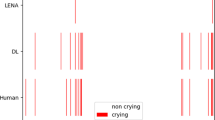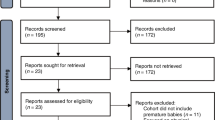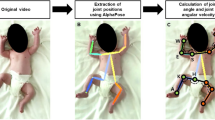Abstract
The early stages of life are paramount for the baby’s brain and emotional development, and the quality of interaction between mother and baby - measured as a dyadic synchrony score, is critical in that period. This study proposes the first machine learning prediction modelling approach, based on Gated Recurrent Unit - GRU ensemble models, to automatically differentiate high from low dyadic synchrony between mother and baby, using a dataset of videos capturing this interaction. The GRU ensemble models which were post-processed by maximising the Youden statistic in a ROC analysis procedure, show a good prediction capability on test samples, including a mean AUC of 0.79, a mean accuracy of 0.72, a mean precision of 0.87, a mean sensitivity of 0.64, a mean f1 performance of 0.72, and a mean specificity of 0.83. In particular the latter performance represents an 83% detection rate of the mother-baby dyads with low synchrony, suggesting these models’ high capability for automatically flagging such cases that may be clinically relevant for further investigation and potential intervention. A Monte Carlo validation procedure was conducted to accurately estimate the above mean performance levels, and to assess the proposed models’ stability. The statistical significance of the prediction ability of the models was also evaluated, i.e. mean AUC > 0.5 (p-value < 9.82 × 10–19), and future research directions were discussed.
Access this chapter
Tax calculation will be finalised at checkout
Purchases are for personal use only
Similar content being viewed by others
References
Winston, R., Chicot, R.: The importance of early bonding on the long-term mental health and resilience of children. London J. Primary Care 8(1), 12–14 (2016)
Feldman, R.: The relational basis of adolescent adjustment: Trajectories of mother–child interactive behaviors from infancy to adolescence shape adolescents’ adaptation. Attach. Hum. Develop. 12(1–2), 2010
Delaherche, E., Chetouani, M., et al.: Interpersonal synchrony: A survey of evaluation methods across disciplines. IEEE Trans. Affective Comput. 3(3) (2012)
Merriam-Webster. (n.d.). Synchrony. In Merriam-Webster.com dictionary
Wiltermuth, S., Heath, C.: Synchrony and cooperation. Psychol. Sci. 20(1) (2009)
Watkins, N., Nwogu, I.: Computational Social Dynamics: Analyzing the Face-level Interactions in a Group. arXiv preprint arXiv:1807.06124. (2018)
Chellali, R., Li, Z.: Predicting arm movements a multi-variate LSTM based approach for human-robot hand clapping games. In: Proceedings of 27th IEEE International Symposium on Robot and Human Interactive Communication (2018)
Cho, K., van Merrienboer, B., et al.: Learning phrase representations using RNN encoder-decoder for statistical machine translation. In: Proceedings of the 2014 Conference on Empirical Methods in Natural Language Processing (2014)
Leclère, C., Avril, M., Viaux-Savelon, S., Bodeau, N., Achard, C., Missonnier, S., et al.: Interaction and behaviour imaging: a novel method to measure mother–infant interaction using video 3D reconstruction. Transl. Psych. 6(5) (2016)
Guedeney, A., Matthey, S., Puura, K.: Social withdrawal behavior in infancy: a history of the concept and a review of published studies using the Alarm Distress baby scale. Infant Ment. Health J. 34(6), 516–531 (2013)
Noor, M.N., Yahaya, A.S., Ramli, N.A., Al Bakri, A.M.M.: Filling missing data using interpolation methods: study on the effect of fitting distribution. Key Eng. Mater. 594–595 (2013)
Dey, R., Salem, F.M.: Gate-variants of Gated Recurrent Unit (GRU) neural networks. In: Proceedings of IEEE 60th International Midwest Symposium on Circuits and Systems (2017)
Aggarwal, C.: Neural networks and deep learning: A textbook. Springer (2018)
Goodfellow, I., Bengio, Y., Courville, A.: Deep Learning, MIT Press (2016)
Bishop, C.: Pattern Recognition and Machine Learning, Springer (2006)
Hastie, T., Tibshirani, R., Friedman, J.: The Elements of Statistical Learning: Data Mining, Inference, and Prediction. Springer (2009)
Geron, A.: Hands-on Machine Learning with Scikit-Learn, Keras, and TensorFlow: Concepts, Tools, and Techniques to Build Intelligent Systems, O'Reilly (2019)
Unal, I.: Defining an optimal cut-point value in ROC analysis: an alternative approach. J. Comput. Math. Meth. Med. 2017 (2017)
Cao, Z., Hidalgo, G., Simon, T., Wei, S.-E., Sheikh, Y.; OpenPose: realtime multi-person 2d pose estimation using part affinity fields. J. IEEE Trans. Pattern Anal. Mach. Intell. 43 (2021)
Rutkowska, K.: Automated measurement of nonverbal synchrony in infant-mother interaction using machine learning, MSc dissertation, supervisors D. Stamate, C. Addyman, Data Science & Soft Computing Lab and Computing Department, Goldsmiths College, University of London (2020)
Acknowledgements
This work was supported by Goldsmiths University of London, and Global Parenting Initiative (Funded by The LEGO Foundation).
Author information
Authors and Affiliations
Corresponding author
Editor information
Editors and Affiliations
Rights and permissions
Copyright information
© 2023 The Author(s), under exclusive license to Springer Nature Switzerland AG
About this paper
Cite this paper
Stamate, D. et al. (2023). Predicting High vs Low Mother-Baby Synchrony with GRU-Based Ensemble Models. In: Iliadis, L., Papaleonidas, A., Angelov, P., Jayne, C. (eds) Artificial Neural Networks and Machine Learning – ICANN 2023. ICANN 2023. Lecture Notes in Computer Science, vol 14262. Springer, Cham. https://doi.org/10.1007/978-3-031-44201-8_16
Download citation
DOI: https://doi.org/10.1007/978-3-031-44201-8_16
Published:
Publisher Name: Springer, Cham
Print ISBN: 978-3-031-44200-1
Online ISBN: 978-3-031-44201-8
eBook Packages: Computer ScienceComputer Science (R0)




